NIKON NUVIS 200 User Manual

 E
E
G
F
Instruction Manual (Pages 2–33) Bedienungsanleitung (Seiten 34–65) Manuel d’utilisation (Pages 66–97) Manual de instrucciones (Páginas 98–129)
S

Foreword
E
Thank you for purchasing the Nikon Nuvis 200 camera.
Your new Nikon camera employs the Advanced Photo System (IX240 system). The symbol T* appears on all Advanced Photo System (APS) format cameras.
Be sure to read this instruction manual thoroughly before use, and keep it close at hand.
*The Advanced Photo System symbol is a trademark of all IX240 products.
Take some trial shots.
Before taking important pictures, be sure to take a few trial shots first to familiarize yourself with the camera and all of its features.
2

Accessories
Check that you have the item shown below before using your camera.
Attaching the wrist strap
Wrist strap
E
Attach the wrist strap by inserting it through the slot as shown.
Optional accessories
•Camera case CS-L21
3

Your Nikon camera features:
■ Choice of three print types (C, H, P), which can be mixed on the |
P. 14 |
E
C-type (classic) |
H-type (wide-vision) |
P- |
Aspect ratio = 2 : 3 |
Aspect ratio = 9 : 16 |
|
■ The 2x power zoom lens covers the |
15 |
|
■When the available light is low, the camera automatically fires the flash. 
■Photographing subjects as close as 0.6m (2 ft.) is possible.  P. 16
P. 16
■The lens cover automatically closes when the camera is turned off to protect the lens from dust and scratches.
4

Contents |
|
Foreword .................................................................................. |
2 |
Accessories ...................................................................................... |
3 |
Your Nikon camera features .............................................................. |
4 |
Camera parts ................................................................................ |
6-7 |
LCD panel indications ...................................................................... |
7 |
Tips on using the Nuvis 200 ............................................................ |
8 |
Getting started |
|
Installing the battery / Checking battery power ................................. |
9 |
Loading the film ....................................................................... |
10-11 |
IX240 film cartridge ....................................................................... |
11 |
Data recording function .................................................................. |
12 |
Basic operation |
|
Holding the camera properly .......................................................... |
13 |
Shutter release operation ............................................................... |
13 |
Viewfinder indications .................................................................... |
14 |
Selecting a print type ...................................................................... |
14 |
Zooming ........................................................................................ |
15 |
Focusing and shooting ............................................................. |
16-17 |
Difficult-to-focus subjects .............................................................. |
17 |
Removing the film .......................................................................... |
18 |
|
Take the exposed film cartridge to a photo lab ............................... |
19 |
E |
To rewind the film in mid-roll ........................................................ |
19 |
|
Advanced operation |
|
|
How to use focus lock .................................................................... |
20 |
|
Selecting the flash mode ................................................................ |
21 |
|
Auto flash photography .................................................................. |
21 |
|
Flash cancel mode ......................................................................... |
22 |
|
Anytime flash mode .................................................................. |
22-23 |
|
Slow sync flash mode .................................................................... |
23 |
|
Red-eye reduction mode ................................................................ |
24 |
|
Self-timer operation ....................................................................... |
25 |
|
Infinity focus .................................................................................. |
25 |
|
Setting the date and time .......................................................... |
26-27 |
|
Other information |
|
|
Troubleshooting ....................................................................... |
28-29 |
|
Specifications ........................................................................... |
30-31 |
|
For safe handling of the camera (WARNING/CAUTION) ........... |
32-33 |
|
5
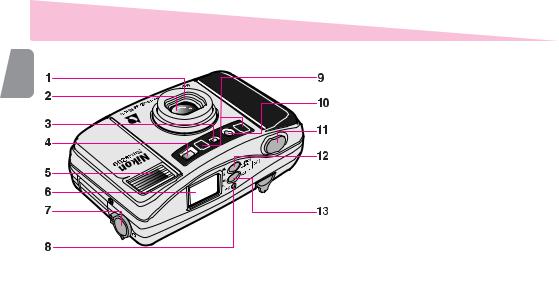
Camera parts
E
1Lens cover (-P. 9)
2Lens
3Auto exposure metering window
4Viewfinder window (-P. 14)
5Flash (-P. 21)
6LCD panel
7CHP selector (-P. 14)
8Mid-roll rewind button (-P. 19)
9Autofocus windows
10Red-eye reduction lamp (-P. 24)
11Shutter release button (-P. 13)
12Power switch ON: $(infinity focus mode)/ J(flash mode) button (-PP. 21, 25)
Power switch OFF: MODE/SEL button (-PP. 12, 26)
13Power switch ON: @ (red-eye reduction)/ C (self-timer) button (-PP. 24, 25)
Power switch OFF: ADJUST button (-P. 26)
6
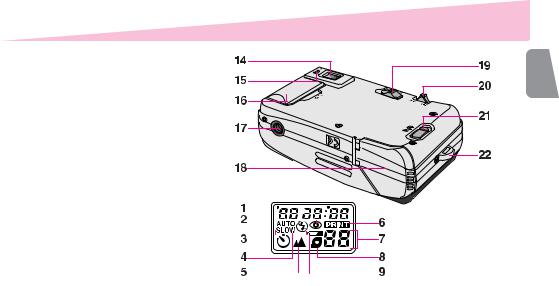
14Viewfinder eyepiece (-P. 14)
15Red LED (-P. 14)
16Battery chamber lid (-P. 9)
17Tripod socket (-P. 25)
18Cartridge chamber cover (-P. 10)
19Power switch (-P. 9)
20Zoom lever (-P. 15)
21Cartridge lock release lever (-P. 10)
22Wrist strap slot (-P. 3)
E
LCD panel indications
1 |
Date and time indicator (-P. 12) |
|
|
|
|
|
|
2 |
Red-eye reduction indicator (-P. 24) |
LCD panel |
|||||
3 |
Self-timer indicator (-P. 25) |
|
|
|
|
|
|
4 |
Flash mode indicator (-PP. 2123) |
|
|
|
|
|
|
5 |
Infinity focus indicator (-P. 25) |
|
|
|
|
|
|
6 |
Data recording indicator (-P. 12) |
|
|
|
|
|
|
|
|
|
|
|
|
||
7Frame counter (-P. 11)
8Cartridge indicator (-P. 11)
9 Low battery power indicator (-P. 9) |
|
|
|
7 |

Tips on using the Nuvis 200
Camera care tips
•Turn the camera off when not in use. This prevents accidental E release of the shutter and resulting battery drain.
•The Nuvis 200 is not a waterproof and therefore should not be exposed to rain or saltwater. If water gets on the camera, wipe it off with a dry cloth immediately.
•Do not subject the camera to high temperatures such as those encountered near a heater or stove or the interior of a car during summer.
•Store the camera in a cool, dry, clean place. Do not expose it to chemicals such as camphor or naphthalene. Using a desiccant during storage is recommended.
•Firing the flash repeatedly makes the battery and camera hot. Allow enough time for them to cool off before taking pictures again.
•Do not drop the camera or hit it against a hard surface.
•Use a dry, soft cotton cloth or commercially available blower brush or lens cleaner to remove dirt and smudges.
•When storing the camera for a long time, remove the battery. Also once a month, insert a battery and fire the flash several times to reform its capacitor.
Notes on battery
•Be sure to check battery power when taking important pictures. Carry spare batteries when traveling abroad.
•Battery power becomes less when the temperature drops below 0°C (32°F). When taking pictures at low temperatures, keep the battery warm. Battery power will recover when the temperature goes back to normal.
Notes on IX240 film cartridge
•Carrying spare IX240 film cartridges is recommended when traveling abroad where the IX240 film cartridges may not be available.
Nikon cannot be held responsible for malfunctions caused by using the Nuvis 200 in ways not specified in this manual.
8
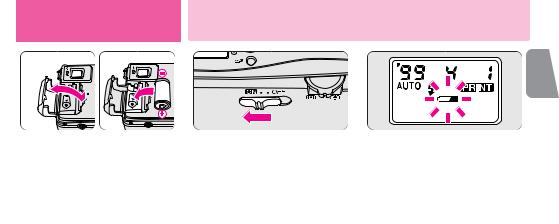
Getting started
1Install the battery.
▼Open the battery chamber lid using a coin or the like.
▼Install one 3V lithium battery CR2 inside the battery chamber.
▼Close the battery chamber lid.
•Reset the date and time, when the battery is replaced and the current data returns to the initial setting.
(- P. 26)
Installing the battery/
Checking battery power
E
3 Check battery power.
•If “b” blinks or nothing appears on the LCD panel, the battery is exhausted and needs to be replaced.
•If a low battery power indicator “b” does not appear, battery power is full.
9

Loading the film
E








1Check that the letter “´ ” is visible on the LCD panel.
•If the number of frames appears on the LCD panel, a partially exposed cartridge is already loaded.
•If the letter “´” and the cartridge indicator “  ” appear on the LCD panel, a cartridge that is fully exposed is loaded and should be removed. (- P. 18)
” appear on the LCD panel, a cartridge that is fully exposed is loaded and should be removed. (- P. 18)
2
1


2Push the cartridge lock release lever in the direction of the arrow to open the cartridge chamber cover.
•The cartridge chamber cover does not open if the battery is exhausted.
3Insert a film cartridge in the cartridge chamber and close the cover.
•Use only IX240 film cartridge. (Regular 35mm film cannot be used.)
•Check that the VEI (Visual Exposure
Indication) shows “○” (unexposed) before loading. (- P. 11)
•Close the cartridge chamber cover until it clicks shut.
10
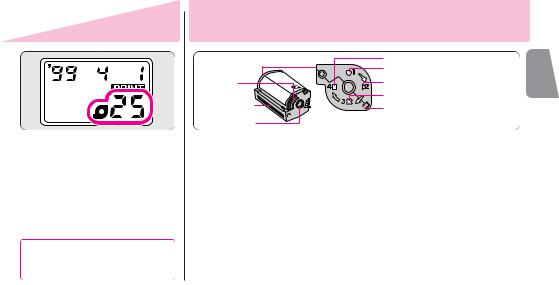
4Check that “ ”and the available number of frames appear on the LCD panel.
”and the available number of frames appear on the LCD panel.
•If the number of frames does not appear, reload the film.
•The letter “´” blinks if a fully exposed film cartridge (the VEI shows “<”) is inserted.
The cartridge chamber cover locks automatically after loading. Do not try to open the cover until film rewinding is completed.
IX240 film cartridge
Data disk
Lightlock door
Lightlock door drive 
Cartridge spool
= Processed film inside the cartridge* |
E |
:Unexposed film* |
|
;Partially exposed film* |
|
<Fully exposed but unprocessed film* |
|
Irreversible Processed Indicator |
|
*Visual Exposure Indication (VEI)
•Available film cartridges: 40-exposure, 25-exposure, and 15-exposure films.
•IX240 film cartridges do not have a film leader. The film is automatically pulled out and set inside the camera.
•The VEI (Visual Exposure Indication) shows the four states of the film.
Notes on handling IX240 film cartridges
•Do not touch, disassemble or apply strong physical shock to the Data disk, Lightlock door or Cartridge spool.
•Do not break the Irreversible Processed Indicator. If broken, consult your nearest photo lab.
•Do not subject the film to direct |
|
sunlight, high temperatures near a |
|
heater or stove, dust and humidity, or a |
|
strong magnetic field. |
11 |
|

Data recording function
E |
MOD |
MOD |
|
SEL |
SEL |
|
ADJUS |
ADJUS |
Set your preferable display mode.
▼Turn the camera off and press the MODE button (once to activate the display, then again to change the mode.)
•The “Year” section is displayed and printed in two digits and the “time” is in 24-hour cycle.
•“- - -” appears when “No recording” mode is selected.
displays. Each time the button is pressed,
|
|
|
|
|
|
|
|
|
|
Day/Month/Year |
||
|
|
|
|
|
|
|
|
|
|
|||
|
|
|
|
|
|
|
|
|
|
|
|
|
|
|
|
|
|
|
|
|
|
||||
|
No recording |
|
Hour/Minute |
|||||||||
|
|
|
|
|
|
|||||||
|
|
|
|
|
|
|
|
|
|
|
|
|
•When shooting while “Å”appeared on the LCD panel, data on the LCD will be recorded. No data is recorded when the “- - -” mode is selected.
•Ask your photo lab that displays an “Authorized Photo Lab Mark” sign for the location of the recorded data.
12

Basic operation |
Holding the camera |
|||
properly |
||||
|
|
|
|
|
|
|
|
|
|
•When holding the camera vertically, make sure that the flash is on top as shown.
flash, or autofocus fingers or hair.
Shutter release operation
E
•Lightly press the shutter release button to achieve focus and exposure and the red LED lights up for a second. While the shutter release button is depressed lightly, the focus is locked. (- P. 20) Press the button all the way until you hear a click to release the shutter.
13
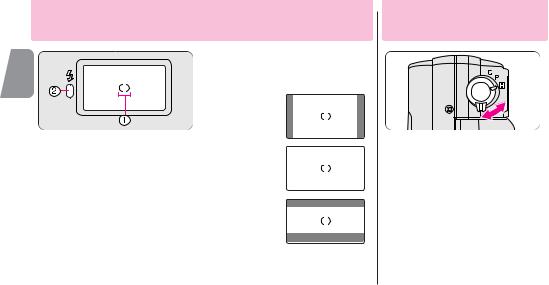
Viewfinder indications
E
1Autofocus frame mark
Center this mark on the subject.
2 Red LED
Press the shutter release button lightly. Then:
—If the LED lights up for a second, focus operation has been completed.
—If it lights up continuously, the flash is ready to fire.
—If it blinks, the flash is being charged and the shutter is locked.
14
Available picture area
Areas cut off in the final print differ depending on the print type (C/H/P).
C-type
(classic)
Aspect ratio = 2 : 3
H-type
(wide-vision) Aspect ratio = 9 : 16
P-type
(panorama) Aspect ratio = 1 : 3
Selecting a print type
Use the CHP selector to select your desired print type before shooting.
•You can select any one of three print types (C, H or P) by switching the CHP selector at any time while film is loaded. (- P. 4) Available picture area differs depending on the print type selected.
•You can also change the type of print when ordering extra prints at the photo lab.
CAUTION!
To prevent possible injury to your eye, hold the camera away from your face when you operate the CHP selector.

Zooming
E
Look through the viewfinder and compose the picture by moving the zoom lever.
▼When the desired image size has been achieved, remove your finger from the zoom lever.
•When the camera is not in use for more than approx. 3 minutes, the lens automatically retracts to the  (wideangle) position.
(wideangle) position.
Move the zoom lever in the 
 direction (48mm) to extend the lens for taking telephoto pictures.
direction (48mm) to extend the lens for taking telephoto pictures.
Move the zoom lever in the  direction (24mm) to retract the lens for taking wide-angle pictures.
direction (24mm) to retract the lens for taking wide-angle pictures.
15
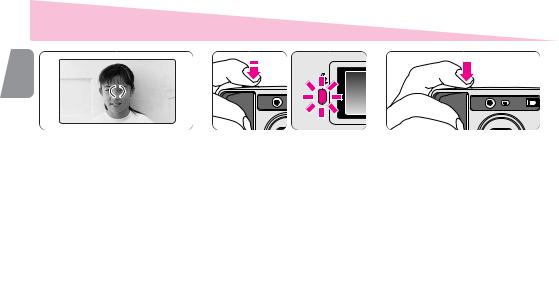
Focusing and shooting
E
1Compose the picture.
•Center the autofocus frame mark on the subject.
2Focus on the subject.
▼Lightly press the shutter release button.
•The red LED lights up for a second when focus operation has been completed.
•To ensure sharp pictures, make sure your subject is at least 0.6m (2 ft.) away from the camera.
16

Difficult-to-focus subjects:
The following subjects may be too difficult to focus. In these cases, use focus lock (- P. 20) by focusing on another subject equidistant from the camera.
•Subjects too small to fully cover the autofocus frame mark
•Subjects behind glass
•Dark subjects with no reflection
•Glossy, light-reflecting surfaces, such as shiny cars or water
•Subjects without solid content (i.e., candle flame, fireworks, etc.)
•Secondary subjects are closer to the camera than the main subject.
E
17

Removing the film
E
The film starts rewinding |
” |
Open the cartridge chamber |
1automatically. |
|
3cover and remove the film. |
•At the end of the film roll, the film rewinds automatically.
•While the film is rewinding, the frame counter counts down one by one.
•If you want to remove the film while the number of available frames still appears on the LCD panel, rewind the film midway through the roll. (- P. 19)
18
open if the battery is exhausted.
Do not open the cartridge chamber cover until the letter “´” starts blinking.
•Releasing the shutter or setting the date and time cannot be performed unless the rewound film is removed.
•When opening the cartridge chamber cover, make sure that the camera bottom faces up, or the cartridge may fall out.
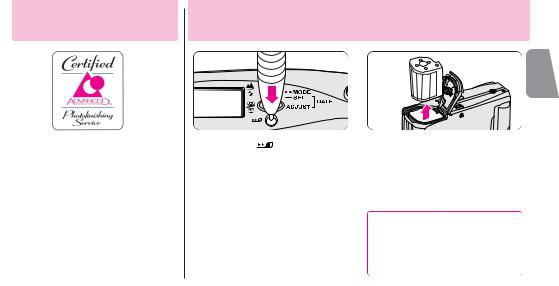
Take the exposed film cartridge to a photo lab.
•We recommend bringing your film cartridge to a photo lab that displays an “Authorized Photo Lab Mark” sign above for processing and printing.
•Your negatives are returned inside the cartridge for easy storage.
•Index prints (small images of each frame exposed on the roll of film) are supplied with the negatives.
•For more information, consult your photo lab.
To rewind the film in mid-roll
E
2Remove the film.
rewind button.
•When rewind is completed, the letter “´ ” starts blinking. Do not try to open the cover until the letter “´ ” starts blinking.
▼Open the cartridge chamber cover.
▼Remove the film.
Once the film has been removed in mid-roll, it cannot be used again. The Visual Exposure Indication (VEI) changes to “<” (fully exposed film). (- P. 11)
19

Advanced operation
E
1Compose the picture.
•When the main subject is outside the autofocus frame mark “ ”, the area behind the subject will be in focus.
”, the area behind the subject will be in focus.
20
How to use focus lock
the center of the frame:
2Center the autofocus frame mark on the main subject.
▼Lightly press the shutter release button.
•Make sure that the red LED lights up for a second.
3Recompose the picture and shoot.
▼While depressing the shutter release button lightly, recompose the picture.
▼Then depress the shutter release button all the way.
•As long as the shutter release button is pressed lightly, focus is locked.
•Do not change the camera-to-subject distance while lightly pressed the shutter release button.
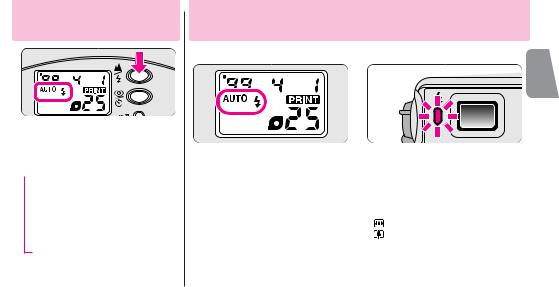
Selecting the flash mode

 MO
MO
 SEL
SEL
ADJUS
Press theJbutton until the desired flash mode indicator appears.
•For details, see the reference page of each
flash mode. |
|
|
→AUTOJ Auto flash |
(-P. 21) |
|
↓ |
Infinity focus (-P. 25) |
|
$ |
||
↓ |
|
(-P. 22) |
# |
Flash cancel |
|
↓
J Anytime flash (-P. 22)
↓
† Auto flash with slow sync
(-P. 23)
•When the camera power is turned off, the flash mode reverts to auto flash.
Auto flash photography
the available light is low.
 E
E
1Turn the camera on.
“• AUTOJ”appears on the LCD panel. Auto flash mode is automatically activated.
•The camera senses when the available light is low and automatically fires the flash.
•When the subject is bright, “#” appears on the LCD panel and the flash does not fire.
Check that the red LED |
|
2comes on, then shoot. |
|
•Before shooting with flash, make sure |
|
the subject is within the flash shooting |
|
distance range. Refer to the following |
|
guide (ISO 200). |
|
(24mm): approx. 0.6 to 5.3 m (2 to 17.4 ft.) |
|
(48mm): approx. 0.6 to 2.8 m (2 to 9.2 ft.) |
|
•If the red LED blinks when the shutter release button is |
|
pressed lightly, the flash is being charged and the shutter |
|
is locked. Lightly press the shutter release button again |
|
and wait for the red LED to light up before reshooting. |
21 |

Flash cancel mode
Use this mode where flash photography is
lighting effect in night scenes.
E 

 MOD
MOD
 SEL
SEL
ADJUS
1Press the J button until “#” appears on the LCD panel.
•Since slow shutter speeds are usually selected in this mode, use a tripod to prevent camera shake.
2Composeshoot. the picture and
▼First lightly press the shutter release button, then push it all the way down to take the picture.
Anytime flash mode
Use this mode to fire the flash intention

 MOD
MOD
 SEL
SEL
ADJUST
1Press the J button until “J” appears on the LCD panel.
22

ally regardless of the available light.
2Composeshoot. the picture and
▼Lightly press the shutter release button.
▼Make sure the red LED lights up, then depress the shutter release button all the way to take the picture.
•If the red LED blinks when the shutter release button is pressed lightly, lightly press the shutter release button again and wait for the red LED to light up before reshooting.
Slow sync flash mode
Use this mode to obtain the correct exposure for both the main subject
and background in low-light situations or at night.
E

 MO
MO
 SE
SE
ADJU
1Press the J button until “†”appears on the LCD panel.
•Since slow shutter speeds are usually selected in this mode, use a tripod to prevent camera shake.
•When the subject is bright, “#” appears on the LCD panel and the flash does not fire.
2Compose the picture and shoot.
▼Lightly press the shutter release button.
▼Make sure the red LED lights up, then depress the shutter release button all the way to take the picture.
•If the red LED blinks when the shutter release |
|
button is pressed lightly, lightly press the |
|
shutter release button again and wait for the red |
|
LED to light up before reshooting. |
23 |
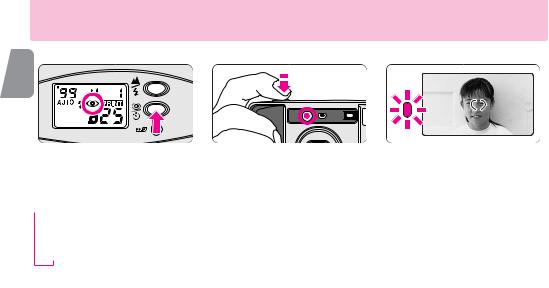
Red-eye reduction mode
In flash photography, the subject’s eyes may sometimes appear bright red. To reduce the “red-eye” effect, use this mode.
E

 MO
MO  SEL
SEL
ADJU
2Compose the picture and lightly press the shutter release button.
•Because the red-eye reduction lamp lights up for a second before the flash fires, be careful not to move the camera or let the subject move until the flash fires.
•The red-eye reduction mode is not recommended when shooting fast-
moving subjects.
24
3Check that the red LED lights up before shooting.
•If the red LED blinks, lightly press the shutter release button again and wait for the red LED to light up before reshooting
•To cancel the red-eye reduction mode, press the @ button until “@”disappears from the LCD panel. This mode can be canceled by turning the power off.
•Red-eye reduction and flash cancel modes can be set together, but in this case red-eye reduction cannot be performed.

Self-timer operation
When you want to include yourself in the picture:

 MO
MO
 SE
SE
ADJU
1Press the C button until “@ C”appears on the LCD panel.
•Self-timer operation will be automatically canceled if not used for more than approx. 3 minutes or the camera is turned off.
•Placing the camera on a tripod is recommended.
2Compose the picture and depress the shutter release button all the way.
•The red-eye reduction lamp blinks for 8 sec., then lights up for 2 sec. before the shutter is released.
•Self-timer operation is canceled after shooting.
•To cancel self-timer operation, turn the camera off.
Infinity focus
Useful for shooting landscapes,
or distant scenes through glass E

 MOD
MOD
 SEL
SEL
ADJUS
Press the $button until “$#” appears on the LCD panel, then fully depress the shutter release button.
•Flash is automatically canceled in this mode.
25
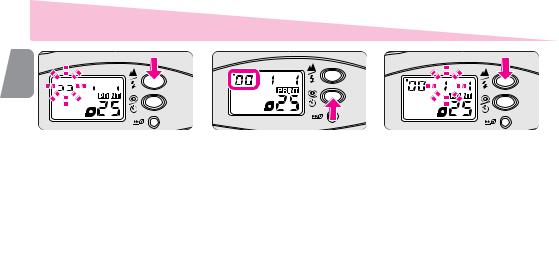
Setting the date and time
E 








 MOD
MOD  SEL
SEL
ADJUS
1Entering the setting mode
▼Turn the camera off and press the SEL button for more than 2 seconds.
•The “year” section starts blinking.

 MO
MO
 SE
SE
ADJU
2Setting the “year”
▼Press the ADJUST button to set the correct year.
•Each time the ADJUST button is pressed, the number changes in increments of one.
•Pressing the ADJUST button continuously for more than 2 sec. changes the number quickly.

 MO
MO
 SE
SE
ADJU
3Setting the “month”
▼Press the SEL button. The “month” section starts blinking.
▼Press the ADJUST button to set the correct month.
▼Press the SEL button.
•Repeat procedures 2 and 3 to set the day, hour and minute.
26


 MO
MO
 SEL
SEL
ADJUS
E
4Gettingmode out of the setting
▼Press the SEL button and the corrected date appears on the LCD panel.
•If the camera is turned on while setting the date/time, all the previously set data will be set at this time.
•The date appearing in the illustration above shows “2000, April, 25.”
When the battery is replaced
•Note that “ - - - ” appears on the LCD panel when the battery is replaced.
•No data will be recorded if “ - - - ” appears on the LCD.
•Repeat procedures from 1 to 4 to set the date and time.
27

Troubleshooting
Check the cause of the trouble using the following chart. It may save you a trip to your nearest Nikon service center.
E |
Problem |
Check this |
Ref. page |
|
The shutter cannot be |
•If the red LED blinks when the shutter release button is pressed lightly, the flash is being charged |
14, 21 |
||
|
||||
|
released. |
and the shutter is locked. Remove your finger from the shutter release button, lightly press the |
|
|
|
|
shutter release button again and wait for the red LED to light up before reshooting. |
|
|
|
|
•If the letter“´”and the cartridge indicator “ ” appear on the LCD panel, the film loaded is not |
10, 18 |
|
|
|
usable. Replace the film with a new cartridge. |
|
|
|
The flash does not fire. |
•If the red LED blinks when the shutter release button is pressed lightly, the flash is being charged |
14, 21 |
|
|
|
and the shutter is locked. Remove your finger from the shutter release button, lightly press the |
|
|
|
|
shutter release button again and wait for the red LED to light up before reshooting. |
|
|
|
|
•Check battery power. If the battery is exhausted, replace the battery with a fresh one. |
9 |
|
|
|
•If the “#”mark appears on the LCD panel, the flash will not fire. |
21 |
|
|
The subject appears out of |
•Clean the autofocus windows if dirty. |
6 |
|
|
focus in the print. |
•To avoid camera shake, gently depress the shutter release button. |
13 |
|
|
|
•When photographing difficult-to-focus subjects, be sure to center the autofocus frame mark on |
17, 20 |
|
|
|
the subject, or use focus lock. |
|
28

Problem |
Check this |
Ref. page |
E |
|
The cartridge chamber |
•The film is not completely exposed. Take pictures up to the end of the roll, or rewind the film in |
11, 19 |
||
|
||||
cover does not open. |
mid-roll. |
|
|
|
|
•The cartridge chamber cover does not open if the battery is exhausted. Replace the battery with |
9, 10, 18 |
|
|
|
a fresh one. |
|
|
|
No indicators appear on |
•The battery was not properly loaded in the battery chamber. Make sure to orient the |
9 |
|
|
the LCD panel when the |
positive (+) and negative (-) poles correctly. |
|
|
|
camera is turned on. |
•The battery is exhausted or no battery is installed. Install a new battery. |
9 |
|
|
|
•If no indicators appear after installing a new battery, the camera is broken. In this case, |
– |
|
|
|
contact your nearest Nikon dealer or a camera shop for repair. |
|
|
|
|
|
|
|
A characteristic of electronic camera
In rare cases, when strong static electricity or the like is applied to the camera, the camera may not work properly. If this happens, remove the battery. Please note that the date and time must be reset when the battery is replaced, because settings are erased when the battery is removed. (+P. 26)
29

|
Specifications |
|
Type of camera |
E |
IX240 (Advanced Photo System) type autofocus AE lens-shutter camera with |
Nikon Zoom 24–48mm f/4.5–8.4 lens |
|
|
Usable film |
|
IX240 System (Advanced Photo System) film cartridge (16.7 x 30.2mm) |
|
Print aspect ratio |
|
C, H and P-type available |
|
Lens |
|
24mm f/4.5–48mm f/8.4 (30mm–60mm converted to 35mm type); |
|
5 elements in 4 groups |
|
Shutter |
|
Programmed electronic shutter; also serves as diaphragm blades; Shutter |
|
speeds: 1/5 to 1/360 sec. |
|
Viewfinder |
|
Real-image zoom viewfinder; frame coverage approx. 85% for H-type printed |
|
image area; approx. 0.32x magnification at 24mm, approx. 0.6x at 48mm |
|
Viewfinder information |
|
C/H/P-type image size frame marks; Autofocus frame; Red LED–Lights up for a |
|
second: completion of focus operation, Lights up: flash ready, Blinks: flash being |
|
charged |
Focusing
Active-infrared autofocus system; Activated by lightly pressing shutter release button; Distance range from 0.6m (2 ft.) to infinity.
Focus lock
Focus is locked as long as shutter button is lightly pressed.
Exposure control
Electronically controlled program AE; Auto exposure range (ISO 200):
EV 8-15 at 24mm, EV 9-16 at 48mm; Flash fires automatically if the available light is low.
Film speed setting
ISO 50, 100, 200, 400, 800 and 1600 film automatically set.
Film operation
Drop-in loading system; Wrong film loading prevention mechanism
Frame counter
Shown in the LCD panel; Count-down type
Self-timer
Electronically controlled; Activated by depressing shutter release button; 10 sec. duration, blinking/lighting up in 2 steps
30
